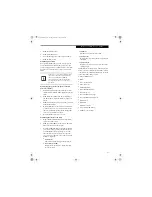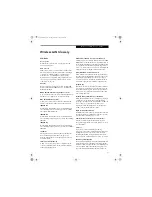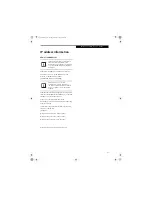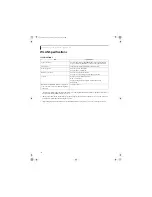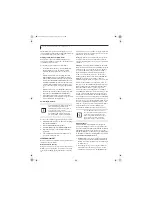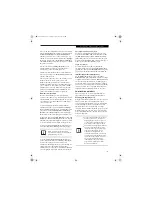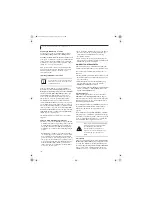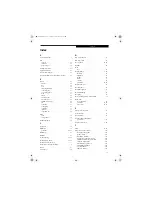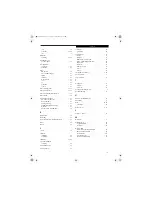
109
U s i n g t h e F i n g e r p r i n t S e n s o r
etc.). The details of each setting under the
Audio
Settings
and
Taskbar Tips
interfaces are self-explana-
tory.
The
Enrollment
interface allows you to enroll finger-
prints. For the procedure to enroll and authentication
device refer to
Chapter 2.3
. To enroll additional finger-
prints, click
Enroll Authentication Device
, and authen-
ticate with OmniPass. Select the fingerprint recognition
device in the
Select Authentication Device
screen (it
should already be marked by a green check if you have a
finger enrolled) and click
Next
.
System Settings
The OmniPass
Startup Options
interface can be found
in the System Settings tab. With these options you can
specify how your OmniPass Logon is tied to your
Windows Logon.
The first option,
Automatically log on to OmniPass as
the current user
, will do just as it says; during Windows
login, you will be logged on to OmniPass using your
Windows login credentials. If the user logging into
Windows was never enrolled into OmniPass, upon login
no one will be logged on to OmniPass. This setting is
appropriate for an office setting or any setting where
users must enter a username and password to log into a
computer. This is the default setting.
With the second option,
Manually log on to OmniPass
at startup
, OmniPass will prompt you to login once you
have logged on to Windows.
With the third option,
Do not log on to OmniPass at
startup
, OmniPass will not prompt for a user to be
logged on.
You can manually log on to OmniPass by right-clicking
the OmniPass taskbar icon and clicking
Log in User
from the right-click menu.
TROUBLESHOOTING
You cannot use OmniPass to create Windows users. You
must first create the Windows user, and you will need
administrative privileges to do that. Once the Windows
user is created, you can add that user to OmniPass using
the same username and password
Cannot add Windows users to OmniPass
If you experience difficulties adding a Windows user
to OmniPass, you may need to adjust your local secu-
rity settings. You can do this by going to
Start,
Control Panel
,
Administrative Tools,
and
Local
Security Settings
. Expand
Local Policies
, expand
Security Options
, and double-click
Network Access:
Sharing and Security Model for Local Accounts
. The
correct setting should be
Classic - Local Users Authen-
ticate as Themselves
.
Cannot add a User with a Blank Password to OmniPass
If you experience difficulties adding a user with a
blank password to OmniPass, you may need to adjust
your local security settings. First attempt the proce-
dure explained in the
Cannot add Windows user to
OmniPass
section. If the difficulties persist, then try
the following procedure.
Click
Start, Control Panel, Administrative Tools,
and
Local Security Settings
. Expand
Local Policies
,
expand
Security Options
, and double-click
Accounts: Limit local account use of blank pass-
words to console login only
. This setting should be
set to Disabled.
Dialog appears after OmniPass authentication during
Windows Logon
After installing OmniPass on your system, you can
choose to logon to Windows using OmniPass. You
authenticate with OmniPass (via master password, or
an enrolled security device) and OmniPass logs you
into Windows. You may, during this OmniPass
authentication, see a
Login Error
dialog box.
This dialog box occurs when OmniPass was unable to
log you into Windows with the credentials supplied
(username and password). This could happen for any
of the following reasons:
■
Your Windows password has changed
■
Your Windows account has been disabled
If you are having difficulties due to the first reason,
you will need to update OmniPass with your changed
Windows account password. Click
Update Password
and you will be prompted with a dialog to reconfirm
your password.
Enter the new password to your Windows user
account and click
OK
. If the error persists, then it is
unlikely the problem is due to your Windows user
account password changing.
E8110.book Page 109 Tuesday, February 28, 2006 2:59 PM
Summary of Contents for E8110 - LifeBook - Core 2 Duo 1.66 GHz
Page 2: ...E8110 book Page 2 Tuesday February 28 2006 2 59 PM ...
Page 8: ...L i f e B o o k E 8 0 0 0 N o t e b o o k E8110 book Page 8 Tuesday February 28 2006 2 59 PM ...
Page 9: ...1 Preface E8110 book Page 1 Tuesday February 28 2006 2 59 PM ...
Page 10: ...L i f e B o o k E 8 0 0 0 N o t e b o o k E8110 book Page 2 Tuesday February 28 2006 2 59 PM ...
Page 13: ...3 2 Getting to Know Your LifeBook Notebook E8110 book Page 3 Tuesday February 28 2006 2 59 PM ...
Page 35: ...25 3 Getting Started E8110 book Page 25 Tuesday February 28 2006 2 59 PM ...
Page 43: ...33 4 User Installable Features E8110 book Page 33 Tuesday February 28 2006 2 59 PM ...
Page 59: ...49 5 Troubleshooting E8110 book Page 49 Tuesday February 28 2006 2 59 PM ...
Page 75: ...65 6 Care and Maintenance E8110 book Page 65 Tuesday February 28 2006 2 59 PM ...
Page 81: ...71 7 System Specifications E8110 book Page 71 Tuesday February 28 2006 2 59 PM ...
Page 87: ...77 8 Glossary E8110 book Page 77 Tuesday February 28 2006 2 59 PM ...
Page 125: ...115 I n d e x E8110 book Page 115 Tuesday February 28 2006 2 59 PM ...
Page 127: ...117 I n d e x E8110 book Page 117 Tuesday February 28 2006 2 59 PM ...

